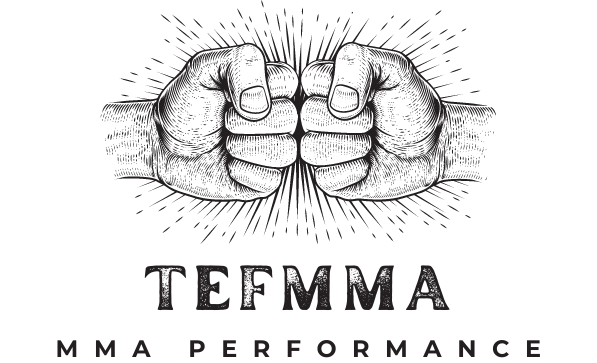Wing Chun and MMA differ in every segment, notably in concept, techniques, and effectiveness. But the main question is — who would win in a Wing Chun vs. MMA matchup, and why?
MMA fighters are superior to Wing Chun fighters in every aspect of real freestyle fighting and will win most of the time. They have superior athleticism and more practical skills and are trained better for real combat.
Overall, MMA conceptually focuses more on the brutal, violent, and unpredictable nature of actual fighting.
Let’s explore this matchup in more detail, see what each style brings to the table, and how these two systems compare in various aspects, such as self-defense.
What Is Wing Chun?
Also known as “Ving Tsun,” this form of combat falls into a group of Kung Fu styles developed in South China around 300 years ago. The modern variation emerged in 1967 when the famous IP Man and seven of his students started teaching their interpretation of the system.
The concept is rooted in self-defense practice, and there is no competition. The focus is fast striking with all limbs, basic joint locks, and grappling principles. Since it is an oriental martial art, students learn to apply all the moves only when their life is in danger.
It also adopts the methods of “chi” training, where the focus is on relaxation. Students would perform martial arts moves in a soft, slow, and relaxed manner to reach a meditative state of mind.
What Is MMA?
Mixed martial arts (MMA) is a popular combat sport developed in the early 90s in the US. The rules resemble legal street fighting and enable the athletes to compete in all combat elements. They can strike on the feet, grapple in the clinch, take each other down to the ground, and use submissions or strikes to finish the match.
The focus is on freestyle combat with few restrictions, notably when it comes to dirty moves. Athletes compete under codified rules in a cage shaped like an octagon or circle, surrounded by a chain-wired fence.
As its name indicates, the sport combines various grappling and striking techniques put into one system. And over time, MMA evolved into its entity and is defined as a hybrid martial art in modern times.
Millions of people around the world practice it for various benefits. For some people, it is a great fitness workout. In contrast, for others, a great self-defense system and sport offer many opportunities.
Wing Chun vs. MMA — Who Would Win In A Fight?
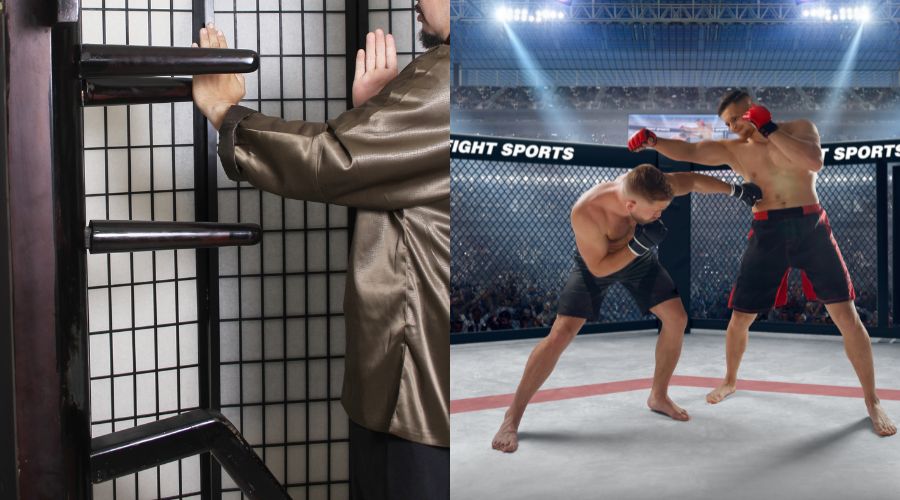
MMA is superior to Wing Chun when it comes to freestyle combat. MMA, as a concept, matches well against anything Wing Chun offers and is a more versatile style. If fighters from both styles with the same skill level get in a fight, MMA will win in most cases.
First, MMA fighters have superior instincts, reactions, and practical techniques. Next, teaching methods add to the realism of fighting. In training, there are a lot of hard sparring or fight simulations where students “fight” each other in spontaneous action.
The main goal of this workout is to teach them how to apply martial art moves against the resisting opponent.
Further, their bodies are conditioned to take damage, their minds to stay calm under pressure, and they have prominent fighting instincts and reactions.
Overall, MMA fighters have all the skills and tools to deal with anything a Wing Chun fighter brings to the table. They are more than capable of blocking all Wing Chun attacks and responding more effectively.
For instance, they can take a Wing Chun athlete down without resistance, as the Chinese system does not include grappling. Once on the ground, it would be a matter of seconds before an MMA athlete would secure a dominant position and finish the fight with one of many chokes or joint locks.
Can a Wing Chun fighter beat an MMA fighter?
Overall, MMA as a system and its techniques are more advanced and effective in a real fight. Even if you isolate other aspects and focus only on striking and fighting on the feet, MMA is still superior in every way.
From stances and guards to kicks, blocks, and punches, Wing Chun would have a hard time winning this fight.
Wing Chun fighters only have a chance to catch an MMA fighter sleeping with some of its unorthodox and “dirty” moves.
A well-placed knee to the groin, strikes to the throat, or poke to the eye can quickly turn the momentum in their favor. But this is not enough to say the system has an advantage over MMA.
Wing Chun vs. MMA — What Are The Main Differences?
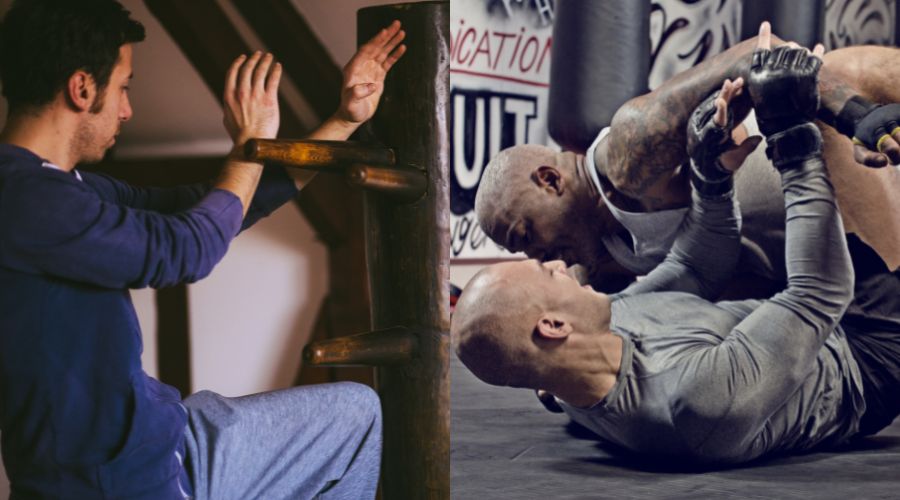
Concept and objectives
MMA is a combat sport where athletes compete to win matches, titles, and money. They train to develop all-around skills to participate in full-contact matches where the rules enable you to fight on the feet, clinch, and on the ground.
The main objective is to cause injuries and hurt the opponent to the point they can no longer continue. The goal is to knock them out cold with strikes, choke them out, or catch in a painful joint lock and force them to surrender.
Wing Chun is an oriental martial art where there is no competition. The key is to improve self-defense skills through standardized teaching methods and overcome oneself through martial art practice. It does not emphasize violence, damage, or hurting the opponent.
It’s instead the total opposite. The main goal is to avoid using full force and focus on using the attackers’ momentum against them. The key is to overwhelm them with technique, speed, and accuracy.
Realism
MMA resembles the brutal and violent nature of street fighting to some degree. MMA fighters train to compete in continuous action, without breaks, and to hurt each other with every strike or grappling move to win the match.
Most of them do not care whether the fight occurs on the ground or on the feet; they all have a comprehensive set of skills.
Wing Chun is a traditional martial art. It focuses on old and standardized teaching methods and techniques. Most schools emphasize pre-arranged forms and some types of live drills.
There is no competition, and sparring is less spontaneous, hard, and realistic than in MMA. The emphasis is on learning patterns and responding to specific attacks using fast and precise striking.
You can use a limited number of techniques under specific circumstances that limit your freestyle combat abilities.
Techniques
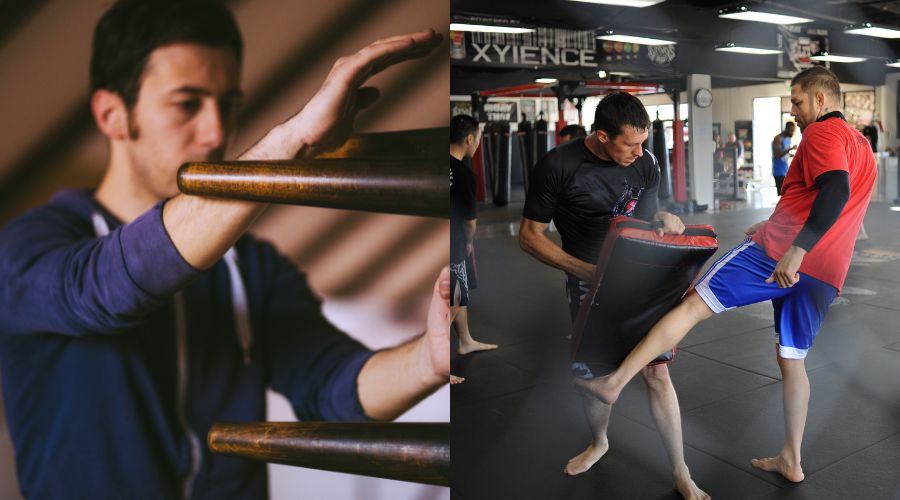
MMA is the most versatile combat system. It includes all techniques from all martial arts, as long as these are within the sport’s rules. Apart from dirty tactics, fighters can utilize just about all strikes and grappling moves. The number of variables and combinations is truly infinite.
And although standardized, MMA techniques and teaching methods are constantly changing and evolving. This also improves the effectiveness of the system in the long run.
- Kicks: roundhouse kicks, front kicks, side-kicks
- Punches: uppercut, hook, cross (backhand), jab (lead hand)
- Takedowns: single/double leg, various throws, trips, and sweeps
- Chokes: guillotine choke, rear-naked choke, Americana, triangle
- Joint locks: kimura, armbar, kneebar
Wing Chun techniques are standardized and have mostly stayed the same since the system was established. The emphasis is on striking with direct punches and kicks at close range and using the knee and advanced elbow striking.
Students also learn dirty tactics such as how to strike the throat, groin area, gouge their eyes, or do anything in their power to protect their lives.
Equipment and gear
MMA fighters use the following gear and equipment in training and competition.
Competition gear: 4oz MMA gloves, shorts, mouthguard, groin cup, hand wraps
Training equipment: Heavy bags, reflex bags, jumping ropes, sparring gloves, shin and knee guards, grappling dummy, and other fitness equipment.
Wing Chun practitioners utilize the following gear and equipment.
- Gi uniform
- Wooden dummies
- Training rings
- Wall Bags
- Chi Sao Dummy
- Butterfly Swords
- Sticks
- Shoes
Wing Chun vs. MMA: Which One is Better For Self-Defense?
MMA is more in line with the violent and unpredictable nature of street fighting and self-defense scenarios. Although it is a sport, MMA rules do not limit its effectiveness and the system’s practicality in real life. In fact, it is far more practical than Wing Chun, which, on the other side, is rooted in self-defense.
Street fights are chaotic and often all over the place, with people striking, grabbing, and falling to the ground. MMA is among the few systems which cover most of the scenarios you may encounter in real life.
Whether you get attacked at the closed range, in open or closed space, with or without enough space to move, you will have the skills to deal with the situation.
Even if the attacker is a trained martial artist, you will still enjoy a significant advantage. MMA matches well against any striking style like boxing, BJJ, or Wing Chun.
Is Wing Chun good for self-defense?
Wing Chun provides you with a solid, basic understanding of self-defense. It teaches you valuable lessons on how to avoid physical confrontation and practical striking skills.
Most of its techniques focus on fast and direct striking when the attacker is close, making it practical in various places such as bars or a room.
Is Wing Chun Good For MMA?
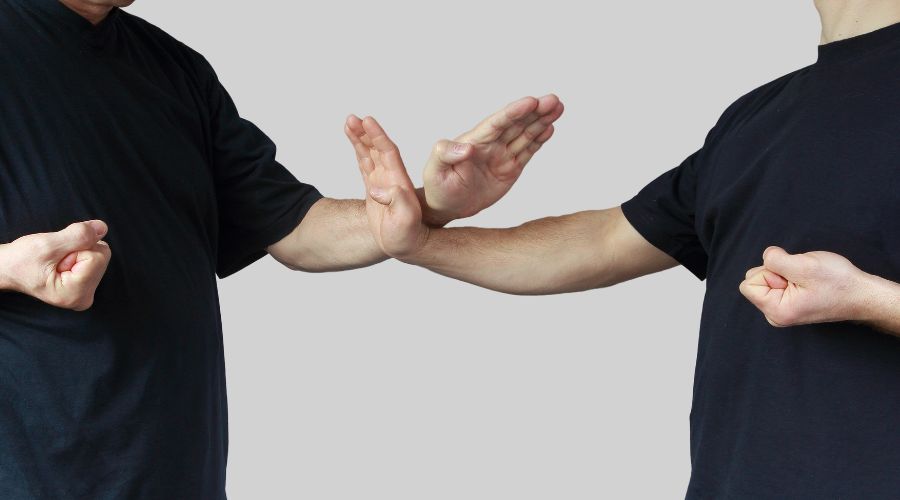
Wing Chun is present in modern MMA, and high-level fighters often utilize some of its moves in fights. However, Wing Chun on its own won’t help you much in cage fighting, nor does it represent a good “MMA base” or starting point on which you can add other techniques.
First, the system does not fit well within the sport’s rules. Wing Chung is a self-defense system and includes various dirty moves, such as eye-gouging, which are not legal in MMA.
Using these moves in a match would end up in an instant disqualification. The stances, guards, movement, and many other elements are also not practical for MMA.
However, some of its techniques and principles are very practical in combination with other skills.
For example, Wing Chun is one of the best martial arts for using your elbows in a fight. It teaches you advanced methods of blocking strikes or attacks at close range.
Muay Thai also includes elbow strikes, but Wing Chun has an even broader range of variations of this specific technique. It also teaches you how to set up the strikes by grabbing and manipulating the opponents’ hands and other valuable moves.
This element of Wing Chun is very practical in MMA, where elbow strikes inside the clinch play a significant role. This standup grappling position is where fighters like Anderson Silva and Tony Ferguson use blocks and attacks directly from Wing Chun effectively.
Overall, Wing Chun does not represent a good MMA base. Most people who want to become cage fighters choose to train in conceptually similar but more effective martial arts such as Muay Thai.
Wing Chun or MMA: Which One Is Harder To Learn?
MMA is a brutal sport and physically more demanding than Wing Chun. It also imposes a greater risk to your health in training and competition and takes more time to master. Let’s examine the following aspects and learn why MMA is harder to learn.
More techniques — MMA
MMA is the most complex combat sport. Students must learn dozens of different kicks, punches, knee and elbow strikes, how to grapple, position on the ground, and submissions. Wing Chun is limited in comparison, mainly focusing on direct punches mixed with elbows and kicks.
Time to learn — MMA
People who enroll in MMA without any martial art background need at least 5 to 10 years of training to develop solid skills.
The ones who come into the sport from BJJ, Wrestling, or other arts might develop the same level of skills in 2–5 years. A person with average talent may expect to reach a high level of proficiency in Wing Chun in around 3 years.
Physically more demanding — MMA
Learning how to mix punches and kicks is challenging. It requires a certain level of athleticism, body mechanics, and overall skills.
Through arduous training, your body will undergo many changes to adapt itself to the nature of the sport. Wing Chun mainly focuses on simple and direct techniques that require little athleticism to perform right.
Wing Chun or MMA — Which One Is For You?
Wing Chun and MMA do not share much in common. Thus, it should be a manageable task for you to decide which one suits you the best, as it all comes down to your personal preference and what you want to achieve.
MMA is an intense sport and physically demanding. It is popular among young people looking to develop all-around skills and get in shape. It is among the most practical self-defense systems, great if you want to improve fitness, and a sport where you can quickly build a career, earn money and become a star.
Wing Chun is an oriental martial art rooted in tradition, philosophy, and self-defense. It is also less intense and physically demanding than MMA and easier to learn. It is also considered a low-impact workout, making it popular among people looking to improve their self-defense skills without risking their bodies.
